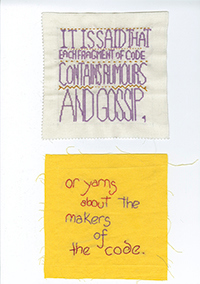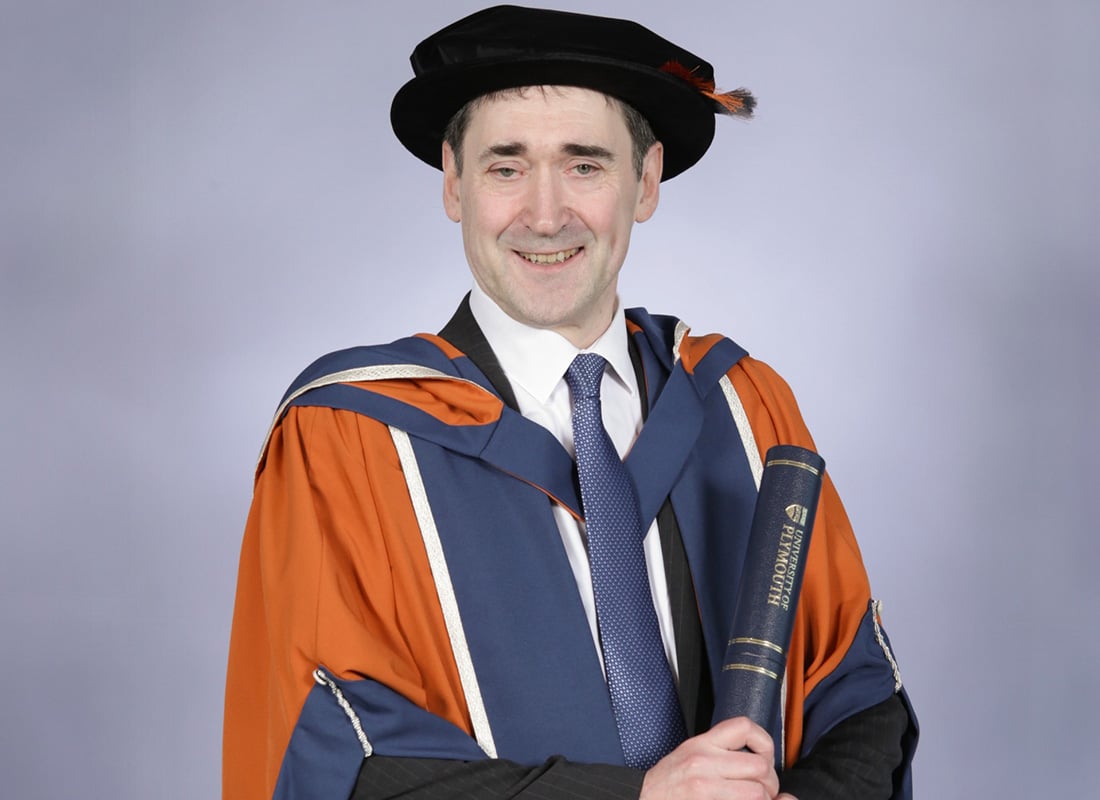 Click image to enlarge
Click image to enlargeCredit: Embroidered Digital Commons: Yarn (2009)
Facilitated by Ele Carpenter.
Top: Amanda Thackray.
Bottom: Abi Nielsen; fabric and embroidery thread.
Copyright the artist; reproduced with permission.
There are strong historical and metaphorical connections between computers and textiles (the first thing that comes to mind being the Jacquard loom).
We typically speak of weaving a web, spinning a yarn and the thread of a story. Our image this month is a poetical and metaphorical response to the definition of the word ‘yarn’.
Yarn also relates to an internet woven of cables wrapped around the world, transmitting our stories and data. What might be the shared characteristics of collaborative production and programming for needlecraft and computing?
The artist Ele Carpenter started the Open Source Embroidery Project in response, she says, to the need for a material investigation of the digital. In her hands, embroidery and code become tools to investigate the language and ethics of participatory creation and distribution.
Hers is a socially-engaged practice that invites people to share their skills and knowledge, whilst investigating the material collaborative nature of computing, code and textiles.
The resulting artwork straddles both conceptual art and folk culture. It is a fascinating take on the digital and unlike anything else being produced in the art world at present. The artist explains, ‘It’s based on the common characteristics of needlework crafts and open source computer programming: gendered obsessive attention to detail; shared social process of development; and a transparency of process and product.’
To date the open source embroidery project has produced exhibitions, workshops and two large scale distributed artworks: Html Patchwork (on display at the National Museum of Computing, Bletchley Park) and Embroidered Digital Commons, a work in progress from which our image this month is taken. This shows two patches stitched by hand in Sweden and just one of over 1,000 pieces being made at present by different people all over the world.
The definition of the word was written by the Raqs Media Collective, a group of artists who wrote ‘A Concise Lexicon of / for the Digital Commons’ (2003). Their Lexicon consists of 26 terms: Access, Bandwidth, Code, Data, Ensemble, Fractal, Gift, Heterogeneous, Iteration, Journal, Kernel, Liminal, Meme, Nodes, Orbit, Portability, Quotidian, Rescension, Site, Tools, Ubiquity, Vector, Web, Xenophilly, Yarn, and Zone. Thus it is an A-Z of the interrelationship between social, digital and material space. The intention is to produce embroidered patches transcribing and illustrating each of these terms.
Ele tells us that the concept of the digital commons is based on the potential for everything that is digital to be common to all. Like common grazing land, this can mean commonly owned, commonly accessed or commonly available. But all of these blurred positions of status and ownership have complex repercussions in the field of intellectual property and copyright.
The commons has become synonymous with digital media through the discourse surrounding free and open source software and creative commons licensing. The digital commons is a response to the inherent ‘copy and paste’ reproducibility of digital data and the cultural forms that they support. Instead of trying to restrict access, the digital commons invite open participation in the production of ideas and culture. Where culture is not something you buy, but something you do.
Ele organises artists, crafters and programmers around the world to stitch and hand-embroider each word. Based in the UK, she holds workshops and events internationally to create a collectively stitched version of this Lexicon as a practical way of close-reading and discussing the text and its current meaning.
Ele says, ‘It weaves together an evolving language of the commons that is both poetic and informative.’ ‘Yarn’, with its play-on-words is particularly amusing. The handcrafted object has a charming, naive quality seemingly at odds with the sophisticated terminology to which it refers.
Ele says her artworks ‘have a precarious status somewhere between art and craft, material and process, professional and amateur.’ And she points out that digital art and socially engaged art, along with craft, are historically on the margins of the modern ‘fine art’ world, functioning simultaneously within the spheres of popular and folk culture.
The whole project is informed by the free and open source software movement. Using the open source methodology Ele rethinks practices of participation, collaboration, the socio-political functions of tools and the relationship between the value of process and a never-finished product. She explains, ‘Open organisational methods simply invite participants to set the parameters within which they agree to work rather than being imposed from a hierarchy or an institution.’
As one of the aims is to facilitate amateur-professional relationships across craft and code, much of the work is produced through workshops, bringing together distinct communities of artists, crafters and software programmers / HTML users to discuss their practice and make new work.
The long list of topics discussed include use of English as the universal programming language, gendered materials, system creativity, software patches and fabric patches and so on.
The primary audience are the people who participate in its production. She has exhibited and run events at the Museum of Craft and Folk Art in San Francisco and galleries in Sweden and the UK, including the recently-opened Furtherfield gallery.
Ele’s essay ‘Open Source Embroidery: Curatorial Facilitation of Material Networks’ has just been published in The Textile Reader, edited by Jessica Hemmings, and the HTML Patchwork is featured on the front cover.
Catherine Mason is the author of A Computer in the Art Room: the origins of British computer arts 1950-80, published in 2008.
More information on the Computer Arts Society, including our events programme












